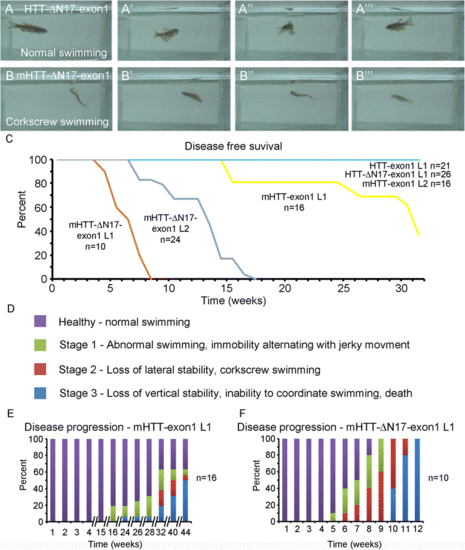Fig. 2
- ID
- ZDB-FIG-160913-2
- Publication
- Veldman et al., 2015 - The N17 domain mitigates nuclear toxicity in a novel zebrafish Huntington's disease model
- Other Figures
- All Figure Page
- Back to All Figure Page
|
mHTT-N17-exon1 transgenic fish develop a progressive motor behavior phenotype. a Panels taken from Additional file 1: Movie S1 showing normal swimming behavior in a HTT-ΔN17-exon1 transgenic fish. b Panels taken from Additional file 3: Movie S3 showing abnormal swimming behavior, corkscrew swimming, in a mHTT-ΔN17-exon1 transgenic fish. c Disease free survival curve for each HTT-exon1 transgenic line corresponding to disease onset. Note that mHTT-ΔN17-exon1 L1 (n = 10) and L2 (n = 24) both develop symptoms earlier than mHTT-exon1 L1 (n = 16) and that mHTT-exon1 L2 (n = 16), HTT-exon1 (n = 21), and HTT-ΔN17-exon1 (n = 26) do not exhibit symptoms in the observed time frame. Kaplan Meier analysis with Log Rank test, p < 0.001 for mHTT-ΔN17-exon1 L1, mHTT-ΔN17-exon1 L2, and mHTT-exon1 L1. d Behavioral characterization within different transgenic lines. Behavior was grouped into four categories: Healthy, Stage 1, Stage 2, or Stage 3 as described. Observations were made weekly. e Disease progression of mHTT-exon1 L1 fish. Note the discontinuous x-axis to account for the extended time frame of behavioral changes (n = 18). f Disease progression of mHTT-ΔN17-exon1 L1. mHTT-ΔN17-exon1 L1 fish developed a robust, progressive motor behavioral deterioration beginning at 5-8 weeks of age and progressing to immobility and death by 12 weeks (n = 10) |
| Fish: | |
|---|---|
| Condition: | |
| Observed In: | |
| Stage Range: | Days 30-44 to Adult |

